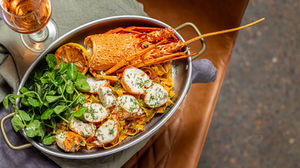Sweet Talking Dessert Wines
- Quentin Von Essen
- Jul 14, 2023
- 3 min read

Liquid dessert? Yes, please! With winter in full swing, it’s time to stock up on your favourite fortified and dessert wines to finish off those cosy dinners and chilly evenings.
Dessert wines are sweet, luscious after-dinner drinks that linger on your palate more deliciously than any mousse, cake or tart. Affectionately known as ‘stickies,’ these sweet wines are a sensational accompaniment to fruit desserts and soft cheeses or as a replacement for dessert at the end of a meal.
Surprisingly, dessert wines are often overlooked and outside of the range of even the most experienced wine enthusiasts - leaving a missed opportunity to create a dynamic dish and dessert wine duo. While there is no industry definition of what constitutes a dessert wine, among winemakers and experts, these wines are broadly regarded as sweet wines that most commonly pair with a dessert.
Dessert wines comprise some of the world’s most lauded, famous, expensive, and delicious wines. Whether red, white, bubbly, still or fortified, a dessert wine is an ideal closer and will have characteristic sweetness and complexity. Fermented in the same manner as conventional white wines, dessert wines tend to be intensely flavoured, deeply gold in colour with bouquets of dried apricots, rich sweet flavours and a sharp acid finish.
In Australia, dessert wines fall broadly into two camps: wines made from grapes that have sweetened on the vine, and those made from wine that has been fortified during winemaking.
The first style is a rich sweet dessert wine often made from Semillon or Riesling grapes, producing light golden and super sweet wines. These wines are made with the highest quality grapes in an unfortified style and can age 50 years or more. This is because their sweetness and acidity preserve their fresh flavour. There are several ways to produce these richly sweet dessert wines:
Late Harvest: These wines are traditionally made from grapes left on the vines until the end of the harvest, so they ripen to their fullest before naturally dehydrating. The result is a wine with a higher residual sugar (or alcohol, depending on how long it is left to ferment). Semillon is the favourite grape used in dessert wines because its thinner skin allows for a more effective state of botrytis and, therefore, sweeter juice. When it comes to food, Foie gras, blue cheese, and light chocolate desserts are excellent pairings for the late-harvest Semillon.
Noble Rot: While it may not sound very appealing, some of the most sought-after dessert wines in the world are made from grapes that are, well… rotten. The fruit is covered in a fungus called botrytis cinerea – also known as ‘noble rot,’ which causes it to shrivel up and dehydrate, leaving behind extra sweet pulp - which the winemakers then press for juice. Some of the world’s most exceptional sweet wines, such as Sauternes from Bordeaux, are made from Noble Rot. Readers may also be familiar with De Bortoli Noble One Botrytis Semillon - arguably Australia’s most famous dessert wine.
These wines are beautiful with desserts such as a fruit tart and perfect when accompanied by sharp washed-rind cheese and blues such as Roquefort.
The second style, the Fortified Wines, such as Sherry, Port, and Madeira, are made by adding alcohol (brandy spirits) during fermentation. This kills the yeasts that convert sugar to alcohol, leaving the wine very sweet and increasing the alcohol level to between 15 and 20%. The type of spirit used and the point in the process that the spirit is added has an enormous impact on the style of wine being made. Generally, the earlier the spirit is added, the sweeter the resulting wines.
After fortification, the wine is left to mature in oak barrels, sometimes for decades, developing into complex, aromatic wines, with immense depth and concentration of flavour and colour. Dessert wines, of course, are most often enjoyed after dinner with a dessert pairing. However, with so many styles and flavours, they also make excellent aperitifs, fantastic cheese or savoury pairings, as well as stand-alone sippers. The happiest match is a not-too-sweet dessert and a modestly sweet wine. Consider poached fruit, citrus or nut tarts or even crème brûlée.
Remember that dessert wines are fantastic for aging – which means you can collect and treasure these wines for some time.











































































































